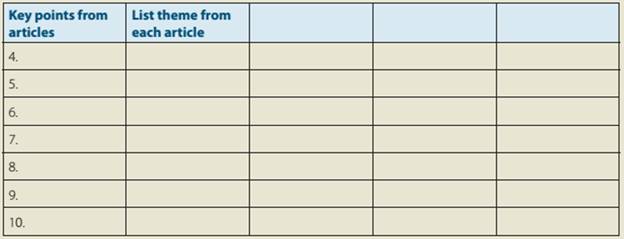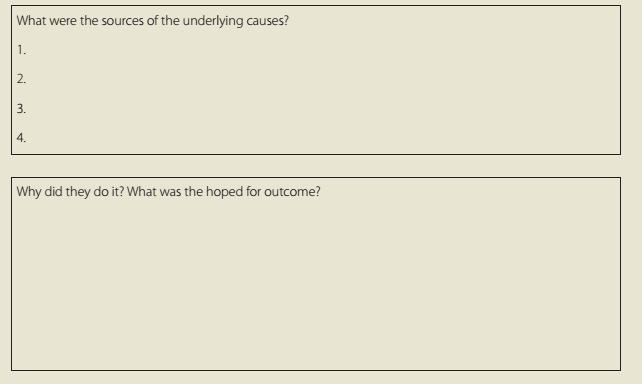
Concept explainers
GROUP LEARNING
Current Events of an Unethical Type83
Step I. Prior to meeting as a group, each person should find two newspaper or magazine articles from the past several months relating to someone violating
Step 2. Summarize the key points of the articles you found.
Step 3. Meet as a group. Have each person share key points from articles with group members.
Step 4. Identify similar themes across the unethical incidents reported in the articles. What was the source or underlying cause of the unethical behavior? What was the hoped—for outcome? Was an individual or a group involved? Did the accused seem repentant or defensive? Can you identify similar conditions of any kind across incidents? Write the common themes in a list on a sheet of paper or whiteboard.
Step 5. What could you as a manager do to prevent such unethical behavior in your organization? What could you do to fix this kind of problem after it occurred in your organization?
Step 6. Report your findings to the class if asked to do so by your instructor.


Then fill in these boxes.

Look at the underlying causes of the unethical behavior.

How often was a group?
How often an individual?

Want to see the full answer?
Check out a sample textbook solution
Chapter 4 Solutions
Understanding Management
- 6 strategies to encourage a risk aware culture in the workplacearrow_forward3. Critically examine the importance of organisational culture in embedding risk management principles in a business. Suggest strategies to strengthen a risk-aware culture. (20 marks)arrow_forward1. Discuss how the application of PESTEL analysis can assist small businesses in identifying and managing external risks. Provide examples from at least three PESTEL categories. (20 marks)arrow_forward
- . Mention four early warning indicators that a business may be at risk.arrow_forward5. A risk that has both a high impact and high probability is referred to as A. Negligible B. Moderate C. Low D. Extreme 6. A business continuity plan is mainly used to_ A. Increase profits B. Handle daily tasks C. Prepare for disruptions D. Advertise services 7. What is the role of a risk owner? A. To finance the risk B. To monitor and manage a specific risk C. To create risks D. To avoid planning 8. Early warning indicators help businesses to A. Avoid legal actions B. Grow rapidly C. Detect potential risks D. Hire employees 9. A hazard-based risk includes A. Political instability B. Ergonomic issues C. Market demand D. Taxation changesarrow_forward1. What is the primary purpose of risk management in small businesses? A. To eliminate all risks B. To predict profits C. To reduce and control risks D. To create new risks 2. Which of the following is a type of operational risk? A. Interest rate change B. Natural disaster C. Supplier failure D. Tax policy change 3. SWOT analysis identifies all EXCEPT A. Strengths B. Weaknesses C. Tactics D. Opportunities 4. Which strategy involves taking no action against a risk? A. Mitigation B. Avoidance C. Acceptance D. Transferarrow_forward
- 5. A risk that has both a high impact and high probability is referred to as A. Negligible B. Moderate C. Low D. Extreme 6. A business continuity plan is mainly used to_ A. Increase profits B. Handle daily tasks C. Prepare for disruptions D. Advertise services 7. What is the role of a risk owner? A. To finance the risk B. To monitor and manage a specific risk C. To create risks D. To avoid planning 8. Early warning indicators help businesses to A. Avoid legal actions B. Grow rapidly C. Detect potential risks D. Hire employees 9. A hazard-based risk includes A. Political instability B. Ergonomic issues C. Market demand D. Taxation changesarrow_forward1. What is the primary purpose of risk management in small businesses? A. To eliminate all risks B. To predict profits C. To reduce and control risks D. To create new risks 2. Which of the following is a type of operational risk? A. Interest rate change B. Natural disaster C. Supplier failure D. Tax policy change 3. SWOT analysis identifies all EXCEPT A. Strengths B. Weaknesses C. Tactics D. Opportunities 4. Which strategy involves taking no action against a risk? A. Mitigation B. Avoidance C. Acceptance D. Transferarrow_forwardList and briefly describe four risk response strategies.arrow_forward
- Explain the purpose of a risk register.arrow_forwardAssume that your business is going to apply for a bank loan. Step into the shoes of a banking official who has the power to say yes or no to your loan application. From the bank’s vantage point, what are the strengths and weaknesses of your business plan? Does your plan seem realistic, given the financial assumptions and the business environment? What questions would you, as a bank officer, ask about your business plan? As the entrepreneur behind the business plan, how would you answer these questions and persuade the bank to approve your loan? Write up your questions and answers in one paragraph. Then use what you’ve learned to further strengthen your plan.arrow_forwardAssume that your business is going to apply for a bank loan. Step into the shoes of a banking official who has the power to say yes or no to your loan application. From the bank’s vantage point, what are the strengths and weaknesses of your business plan? Does your plan seem realistic, given the financial assumptions and the business environment? What questions would you, as a bank officer, ask about your business plan? As the entrepreneur behind the business plan, how would you answer these questions and persuade the bank to approve your loan? Write up your questions and answers in one paragraph. Then use what you’ve learned to further strengthen your plan.arrow_forward
 Understanding Management (MindTap Course List)ManagementISBN:9781305502215Author:Richard L. Daft, Dorothy MarcicPublisher:Cengage Learning
Understanding Management (MindTap Course List)ManagementISBN:9781305502215Author:Richard L. Daft, Dorothy MarcicPublisher:Cengage Learning Management, Loose-Leaf VersionManagementISBN:9781305969308Author:Richard L. DaftPublisher:South-Western College Pub
Management, Loose-Leaf VersionManagementISBN:9781305969308Author:Richard L. DaftPublisher:South-Western College Pub


